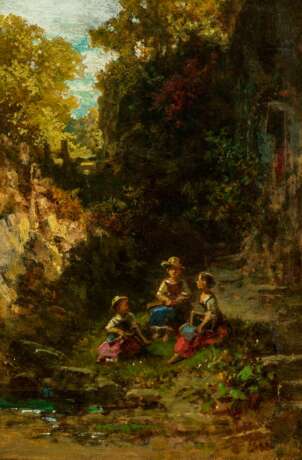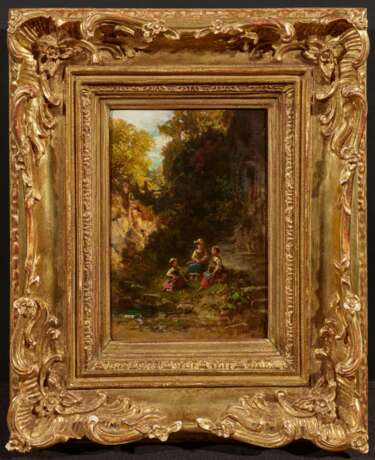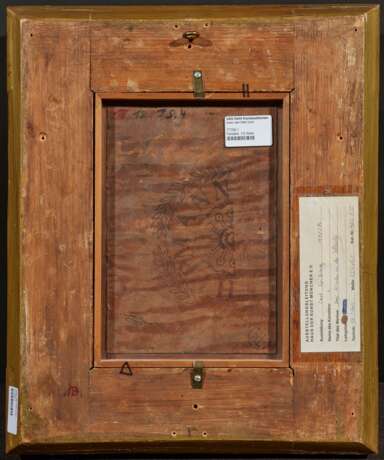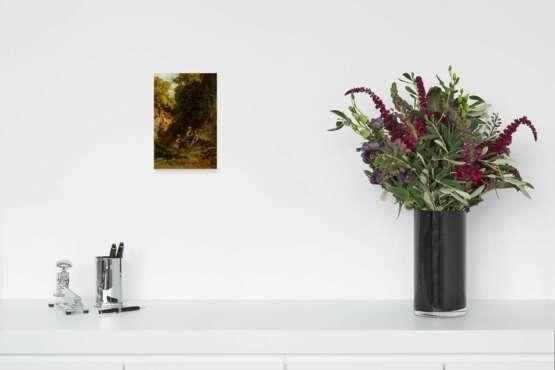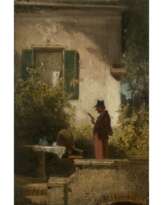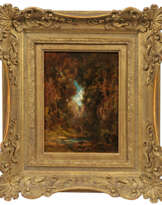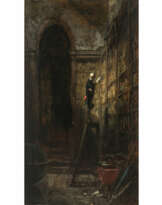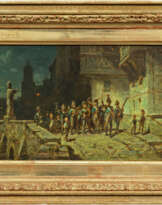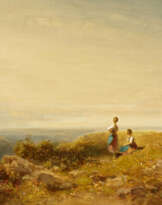ID 1208119
Lot 1133 | Carl Spitzweg. Three School Girls Resting
Valeur estimée
€ 30 000 – 40 000
Title: Three School Girls Resting.
Three girls sitting while talking, in the background a path and a garden gate, on the right trees and a "Marterl".
Date: Ca. 1875.
Technique: Oil on wood.
Measurement: 21,5 x 13,5cm.
Frame: Framed.
Verso:
On the panel (former lid of a cigar box by H. Upmann) estate stamp and on the frame exhibition label Haus der Kunst, Munich.
Literature:
S. Wichmann: Carl Spitzweg. Verzeichnis der Werke - Gemälde und Aquarelle, Stuttgart 2002, cat. rais. no. 914, p. 387f with ill.
S. Wichmann: Carl Spitzweg. Kunst, Kosten und Konflikte, Frankfurt am Main 1991, p. 244 with ill.
S. Wichmann: Carl Spitzweg and the French draughtsmen Daumier, Grandvile, Gavarni, Doré. Catalogue of the exhibition at Haus der Kunst Munich 23.11.1985 - 02.02.1986, no. 625 with ill. p. 340.
In his catalogue raisonné on Spitzweg, Wichmann states that a very precise preparatory drawing for the present painting on wood exists in one of the sketchbooks from 1869. In our work, executed in oil, it is clear to see "that the painter endeavoured to vary the theme, although he adhered to the compositional elements."
Provenance:
Private collection, Germany.
Alongside Caspar David Friedrich, Carl Spitzweg is probably the most popular German visual artist of the 19th century. With his loving view of the people and situations he depicted, the painter of the "Poor Poet" or the "Cactus Friend" had a decisive influence on the general perception of the Biedermeier period.
Born into a wealthy Munich merchant family in 1808, Carl Spitzweg grew up in a sheltered environment. He remained loyal to the Bavarian capital throughout his life; it was here that he learnt the profession of pharmacist and completed his studies in pharmacy, chemistry and botany "with distinction". But just one year later, in 1833, the young man, who had always enjoyed drawing and writing creatively, decided to devote himself entirely to painting.
Thanks to inheritances, Spitzweg was financially independent and gave himself a period of 15 years to experience and assert himself in the insecure life of an artist. If he did not succeed, he planned to return to the profession of pharmacist at the age of 40.
A circle of painter friends, including Christian Heinrich Hansonn (1791 - 1863), Eduard Schleich the Elder (1812 - 1874) and Heinrich Heinlein (1803 - 1885), gave the self-taught artist valuable advice and encouraged him in his decision.
And Carl Spitzweg was quickly successful; his often small-format works, aimed at a new group of middle-class buyers, soon sold well. As a member of the young Munich Art Association, he further established himself as an artist and received commissions as an illustrator and author from the humorous weekly magazine "Fliegende Blätter".
However, the loyal and extremely hard-working painter was above all a frequent traveller who was open to innovations in the (art) world. Together with his artist friends - above all Eduard Schleich the Elder - he undertook countless journeys and extensive hikes. Every year he gathered impressions in Bavaria, the Alpine region, northern Italy and Dalmatia.
One journey that was particularly important for his artistic work took Carl Spitzweg together with his brother and Eduard Schleich the Elder to Paris in 1851 and from there to the first World Exhibition in London. In Paris, he was fascinated by the works in the large art collections, but above all he made contact with the artists of the Barbizon School, whom he also visited in the forest of Fontainebleau.
Spitzweg was impressed and fascinated by the direct painting of the landscape, the resulting novel handling of light and shadow, the non-linear, painterly use of colour and also the stage-like composition of the landscapes as practised by the group around Théodore Rousseau, Camille Corot and Charles Francois Daubigny. His subsequent confrontation with the works of William Turner in London led his artistic endeavours in the same direction.
There are many paintings in Carl Spitzweg's oeuvre that directly reflect the influence of this trip in 1851. This also applies to the present work "Three Resting Schoolgirls". The three are sitting on an embankment as if on a stage. The narrow forest scene with the path ascending into the background and the stream babbling parallel to it in the foreground on the left forms a cosy corner. Here the friends can chat undisturbed. The colours of their skirts and aprons and the light-coloured tops and headdresses set accents in the largely shaded surroundings. A small section of the sky can be seen in the top left-hand corner of the picture. Bright summer light only touches the left side of the ascending slope. The wayside shrine at the edge of the path, on the right-hand edge of the picture, recedes completely in colour. In the sense of the Barbizon artists, this is truly a "paysage intime".
Although the figures are painted almost entirely without any internal drawing, Carl Spitzweg, the master of psychological typification, manages to say something about the three girls. Posture, contour and sitting position characterise the children and their relationship to each other. The atmospheric, slightly dim light and the seclusion of the spotlight may conjure up memories of the viewer's own childhood, of carefree and unobserved moments with their best friends.
In the 1860s and 70s, Carl Spitzweg frequently varied the theme of (school) children in the forest. Siegfried Wichmann dates this particularly atmospheric painting, which, like so many of Spitzweg's works, was painted on the lid of a cigar box, to around 1875.
| Artiste: | Carl Spitzweg (1808 - 1885) |
|---|---|
| Technique appliquée: | Huile |
| Catégorie maison de vente aux enchères: | Peinture 19ème siècle |
| Artiste: | Carl Spitzweg (1808 - 1885) |
|---|---|
| Technique appliquée: | Huile |
| Catégorie maison de vente aux enchères: | Peinture 19ème siècle |
| Adresse de l'enchère |
VAN HAM Kunstauktionen GmbH Hitzelerstr. 2 50968 Köln Allemagne | ||||||||||||||
|---|---|---|---|---|---|---|---|---|---|---|---|---|---|---|---|
| Aperçu | |||||||||||||||
| Téléphone | +49 221 92586215 | ||||||||||||||
| Fax | +49 221 92 58 62 4 | ||||||||||||||
| Commission | 32% | ||||||||||||||
| Conditions d'utilisation | Conditions d'utilisation | ||||||||||||||
| Heures d'ouverture | Heures d'ouverture
|
